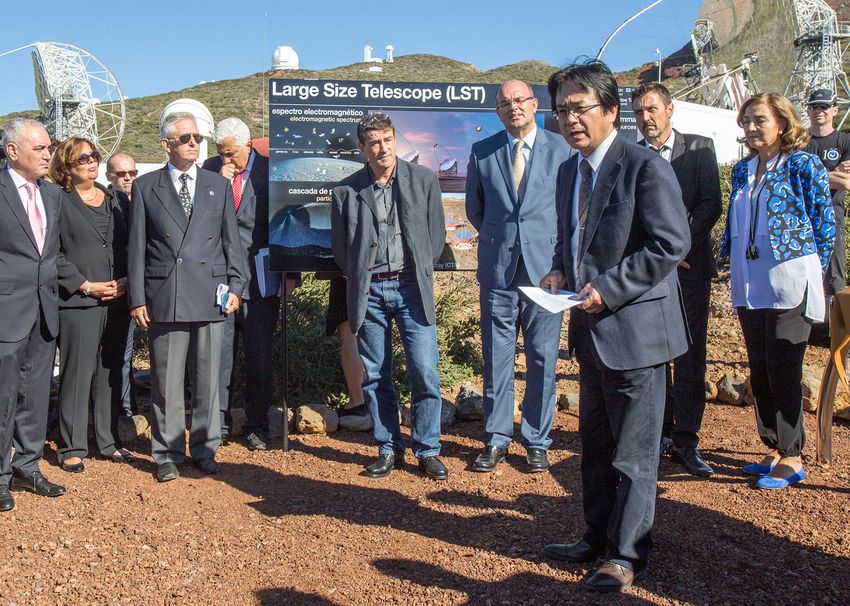The first stone event marks the start of a highly ambitious project – the Cherenkov Telescope Array (CTA), designed to observe different energy ranges in the gamma ray spectrum. Its objective is to study the astrophysics of high-energy gamma rays, allowing us to further our knowledge of the most violent and “extreme” objects and processes in the Universe, such as active galactic nuclei or gamma ray bursts.
The prototype telescope LST, which will be used to validate the large sized telescopes of the CTA could become the first telescope of the array when the agreement between Spain and the CTA consortium, by which the CTA-North is installed in the island of La Palma, comes into force. The CTA will be a major scientific infrastructure combining 100 telescopes divided between two observatories in the northern and the southern hemisphere.
Address by Nobel Prize Winner Takaaki Kajita
The groundbreaking ceremony took place on October 9, 2015 in the presence of international and Spanish authorities. Masahiro Teshima, LST’s principal investigator and director of the Max Planck Institute for Physics, and Manel Martínez (IFAE, Institut de Física d’Altes Energies, Barcelona) chair of the steering committee of the LST, explained the authorities the telescope’s structure and functions. A plaque with a bas-relief representation of the telescope was unveiled.
Teshima emphasized the role of the LST prototype: “We hope to get a much better understanding for objects that emit gamma radiation – like gamma ray bursts which are produced when extremely large stars collapse to form black holes or neutron stars.”
After the stone laying there were addresses by Rafael Rebolo, director of the Astrophysics Institute of the Canary Islands (IAC), Takaaki Kajita, director of the Institute for Cosmic Ray Research (ICRR; Tokyo), and by Carmen Vela, the Secretary of the State for Research as well as regional and local authorities.
Kajita was greeted with enthusiastic applause for his Nobel Prize for Physics awarded for the discovery of neutrino oscillations. On behalf of his institute he wished the CTA consortium a “successful construction of the first LST and a great start of the CTA project.”
New insights on fascinating objects in the universe
The dimensions of the LST are outstanding, both by the diameters of its mirror (23 meters) and the camera (3 meters). The camera detects the Cherenkov light generated when gamma rays interact with the molecules in the earth’s atmosphere. It is one of the most complicated and rapid cameras in the world. Gamma radiation allows us to study physical processes, which emit the biggest quantities of energy in the universe: among them supernova explosions, black holes, microquasars, active galactic nuclei, and gamma ray bursts. CTA will also be used for the search of dark matter and to study the possible quantum structure of space-time. The CTA collaboration includes 30 countries, with some 1500 engineers and scientists. The project of the LST prototype is led by Masahiro Teshima, the co-leader is Juan Cortina, IFAE. Japan, Germany, and Spain are the main contributors to the LST consortium, in which further participants are France, Italy, Brazil, Sweden, India and Croatia.
Institutions of the LST consortium:
- ICRR, University of Tokyo, Japan
- Centro Brasileiro de Pesquisas Fisicas, Brazil
- CTA-Croatia Consortium, Croatia
- CNRS/LAPP, France
- Max Planck Institute for Physics, Germany
- Hamburg University, Germany
- Saha Institute of Nuclear Physics, India
- INFN, Italy
- University of Padova, Italy
- CTA-Japan Consortium, Japan
- CIEMAT, Spain
- ICE-CSIC-IEEC, Spain
- ICC-UB, Spain
- IFAE-BIST, Spain
- UCM, Spain
- Stockholm University, Sweden
